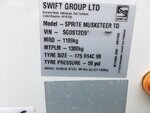Your stance seems to be confusing:-
You seem to supporting the suggestion that caravan owners should consider upgrading from OEM tyres (caravan manufacturers specification).
Correct, which is what the CMCH recommend considering, which is one of the quotes I provided. OEM is often underspect. not on necessarily on loaings, but on quality.
Yet you are also suggesting that upgraded tyres will suffer more on TA's. So how can a TA caravanner choose a suitable tyre?
Correct, and this is where it is difficult to obtain definitive supporting evidence, my knowledge is hearsay, and what I have read elsewhere. This is why I was careful to advice getting advice from the manufacturers. If I was purchasing for a twin axle, it is certainly what I would do. I believe, which means it is just my summation. That say upgrading to commercial tyres with much stronger side wall would not cope with the twist like good quality car tyres.
I have no connection with Cooper/Avon or the CHMC so if you need clarification on their position advice you must speak with them.
Someone recently started a thread about Avon. For whatever reason they do not recommend there tyre for use on caravans. I have no wish or need to speak with them. I was merely saying there is more to consider when purchasing tyres than the size and load rating etc.
Re CHMC I provided the link to be inspected to support what I was saying. You don’t need a ‘connection’ with them in order to read it.
I am more than aware of the complexities that twin axles bring across a variety of issues not just tyres, but I equally believe the chassis manufacturers in particular will also have a good understanding of the forces involved, and will have designed and specified components that are satisfactory to cope with those forces for their given loads. They will have advised their customers (e.g. caravan manufacturers) of the minimum specification tyres to use to keep the trailer road legal and safe.
Companies can of course get it wrong sometimes, but for both the chassis manufacture and teh caravan body manufacture to both get it wrong is a diminishing probability.
Absolutely, completely agree, but as you say. “Minimum“ specification.
All the OP needs to do is source tyres of the same specification.
In the first case the OP did not fully quote the tyre markings or mention that it was a twin. But the answer in the form you suggest was clearly provided by myself and others in the first few posts.
This was then extended into a fuller discussion typicle of many/most forum topics and what sets them apart from a Q&A. Confusion was introduced which is worrying as these are people who choose and specify for their own caravans.



